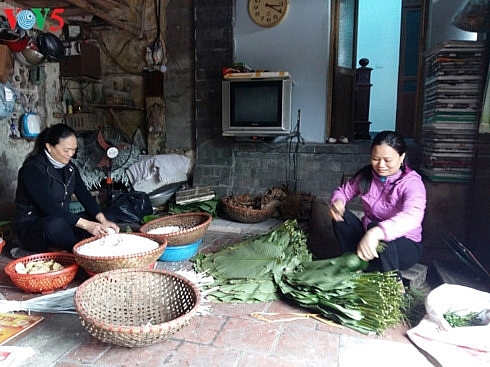Dam village makes Chung cake, cassava vermicelli
 |
| Making Chung cakes at Nguyen Thi Phuong’s house. |
Dam is one of Vietnam’s multi-craft villages. At first, Dam villagers made Chung cakes just for themselves and their neighbors. It eventually turned into the main trade of locals.
Along with Lo Khe, Tranh Khuc, and Phu Thuong village in Hanoi and Bo Dau in Thai Nguyen, Dam village has a reputation for making Chung cakes.
Dam villagers cook Chung cakes all year round but are busiest on the 1st and 15th day of each lunar month and at Lunar New Year. Though Dam-branded Chung cakes are wrapped by hand, all are neatly shaped.
Villager Nguyen Thi Phuong told VOV, “We select the best ingredients. The stuff has green bean and mixed lean and fat pork. The ‘Dong’ leaves should be not too old or young. The cakes are boiled for 10 hours.”
Pham Van Luan, an experienced Chung cake maker, explained why Dam Chung cakes are greasy, glutinous, and sweet-smelling.
Luan said, “My family makes both Chung and Giay round glutinous rice cakes. Basically the techniques are the same as in other villages across Vietnam. To make delicious cakes, you need to cook the green bean without stirring, as if cooking rice. It’s essential to form tightly-packed green bean balls when the green bean is still hot. Our secret is to boil the cakes in rainwater so they will keep for many days.”
Making cassava vermicelli is a second main craft of Dam village. It gives villagers a relatively good income, so they produce it all year round with an average productivity of 2 tons a day.
Villager Phuong says that in recent years Dam vermicelli has been exported to Laos, Cambodia, and Thailand, adding, “In the past, making Chung cakes was the only traditional craft of the village. Now we have other trades like making tofu, cassava vermicelli, rice noodles, and Giay cakes.”
Dam village’s products have been sold to neighboring provinces and cities. Thanks to multiple crafts, the lives of Dam villagers have significantly improved.
What the stars mean:
★ Poor ★ ★ Promising ★★★ Good ★★★★ Very good ★★★★★ Exceptional
Latest News
More News
- The destinations powering Vietnam’s festive season travel demand (December 04, 2025 | 18:33)
- Vietnam named among the world’s most exciting winter destinations (December 04, 2025 | 15:10)
- Phu Tho emerges as northern Vietnam’s new tourism hub (December 01, 2025 | 17:00)
- Vietjet completes Airbus A320/A321 updates ahead of deadline (December 01, 2025 | 09:49)
- Vietjet resumes Con Dao flights from early December (November 28, 2025 | 15:24)
- Free tickets, Lunar New Year promotions on offer at Vietjet Mega Livestream (November 26, 2025 | 15:32)
- Scandinavian Airlines and Vietnam Airlines broaden agreement with new routes (November 25, 2025 | 17:04)
- Halong Cruise Port welcomes over 3,100 international visitors (November 12, 2025 | 18:06)
- Vietnam.travel climbs to second place in Southeast Asia website rankings (November 12, 2025 | 18:01)
- Cat Ba named among Southeast Asia’s top island adventures (November 11, 2025 | 18:09)

 Tag:
Tag:

















 Mobile Version
Mobile Version